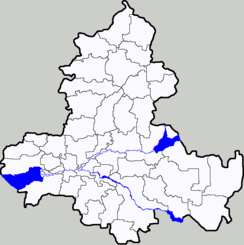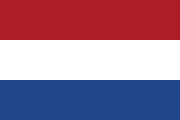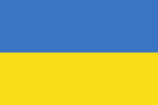Taganrog
| Taganrog (English) Таганрог (Russian) |
|
|---|---|
| — Inhabited locality — | |
 The port of Taganrog from the air in 2006 |
|
.svg.png) Location of Rostov Oblast in Russia |
|
 Taganrog
|
|
| Coordinates: | |
_(1808).png) |
.png) |
| Holiday | September 12 |
| Administrative status | |
| Country | Russia |
| Federal subject | Rostov Oblast |
| Municipal status | |
| Urban okrug | Taganrog Urban Okrug |
| Mayor[1] | Nikolay Fedyanin[2] |
| Representative body | City Duma[3] |
| Statistics | |
| Area | 111 km2 (43 sq mi) |
| Population (2002 Census) | 279,000 inhabitants[4] |
| - Rank | 66th |
| - Density | 2,514 /km2 (6,510 /sq mi)[5] |
| Time zone | MSK/MSD (UTC+3/+4) |
| Founded | September 12, 1698[6] |
| Previous names | Troitsk (until 1784) |
| Postal code(s) | 347900 |
| Dialing code(s) | +7 8634 |
| Official website | |
Taganrog (Russian: Таганрог, [təɡʌnˈrok]) is a seaport city in Rostov Oblast, Russia, located on the north shore of Taganrog Bay (Sea of Azov), a few km west of the mouth of the River Don. Population: 279,000 (2005 est.); 281,947 (2002 Census);[4] 291,622 (1989 Census).[7].
Contents |
History of Taganrog
The first Russian Navy base, Taganrog was officially founded by Peter I The Great on September 12, 1698 and hosted the Azov Flotilla of Catherine the Great (1770–1783). This flotilla subsequently became the Russian Black Sea Fleet.
By the end of the 18th century, Taganrog lost its primacy as a military base after the Crimea and the Azov Sea was absorbed into the Russian Empire. In 1802, Alexander I of Russia granted the city the status of Taganrog Governorate, which existed until 1887. The governor was in direct contact with H.I.M. In 1825, the Alexander I Palace in Taganrog was used as the tsar's summer residence, where he died in November 1825.
Taganrog was important as a commercial port. By the end of 19th century-early 20th century it was used for imports and exports of grain. Belgian and German investors founded a boiler factory, an iron and steel foundry, a leather factory and an oil press factory. By 1911, 15 foreign consulates had opened in the city[8].
During May-August 1918, the city was occupied by the German troops of the Kaiser. In 1919 General Anton Denikin kept his headquarters at the Avgerino mansion in Taganrog. When Soviet power was established on 25 December 1919 Denikin's remaining troops and the British Consulate were evacuated by HMS Montrose.
In World War II Taganrog was occupied by Germans between 1941–1943. Two SS divisions entered the city in October 1941 followed by other military divisions and the city suffered extensive damage. The local government system was replaced by Bürgermeisteramt or "New Russian local government". Taganrog was liberated on August 30, 1943.
Taganrog in literature and popular culture


The image of the city and its people is featured in numerous Anton Chekhov works, including Ionych, The House with an Attic, The Man in a Shell, Van'ka, Three Years, Mask, My Life and more. It is believed that Taganrog image may be used as Lukomorie (fairy tale land) in Alexander Pushkin's Ruslan and Lyudmila (1820). It also appeared in the novels of Ivan Vasilenko, Konstantin Paustovsky and in the poems of Nikolay Sherbina and Valentin Parnakh.
The conspiratorial legend of "Elder Fyodor Kuzmich" is cited in the book Roza Mira by Russian mystic Daniil Andreyev. According to this legend, the Russian tsar Alexander I did not die in Taganrog, but instead left his crown and the status of monarch to continue his life as a traveling hermit.
In 1984, the city was mentioned in the Mashina Vremeni song Razgovor v Poezde (Conversation on the Train).
In 2004 Irish poet of German heritage Sabine Wichert published a collection of poems titled Taganrog.
In 2006, the city was mentioned in the Aquarium's song The Meaning of All Existing Things (O Smisle Vsego Sushevo) from the album Bespechniy Russkiy Brodyaga(Carefree Russian Wanderer).
In 2006 in Aquarium's song Unknown Facts from Elvis Presley's Biography («Неизвестные факты из биографии Элвиса Пресли»):
Elvis Presley was a son of the Empress of Venus and a smuggler from Taganrog.
«Элвис Пресли был сыном императрицы с Венеры и контрабандиста из Таганрога»
On 29 January 2010 Russian President Dmitri Medvedev visited the city of Taganrog as part of the commemorative events for the 150th anniversary of the great Russian writer Anton Chekhov[9][10][11][12].
One of the fictional personalities (Sergey Yurievich Belyakov, played by Sergey Svetlakov) on the TV sketch show Nasha Russia is from Taganrog.
In foreign literature, the city was mentioned in the titles of the following novels: Der Tote von Taganrog by Eberhard von Cranach-Sichart, Taganrog (dedicated to death or disappearance of Alexander I of Russia) by Reinhold Schneider.
Notable people
Numerous Russian and international aristocrats, politicians, artists, and scientists were born and/or have lived in Taganrog. Taganrog is the native city of Anton Chekhov, Faina Ranevskaya, Sophia Parnok, Alexandre Koyré and Dmitri Sinodi-Popov; names of Russian emperors Peter I of Russia and Alexander I of Russia; Cornelius Cruys, Giuseppe Garibaldi, Pyotr Tchaikovsky, Konstantin Paustovsky, Nestor Kukolnik, Achilles Alferaki, Ioannis Varvakis, Sergei Bondarchuk and many other famous people are brought in mind when Taganrog is named.
Economy
The city of Taganrog is the leading industrial center of the Rostov Oblast. Local industry is presented by aerospace, machine-building, automobile, military, iron and steel industry, engineering, metal traders and processors, timber, woodwork, pulp and paper, food, light, chemical and industry of construction materials, and one of the major ports of the Azov Sea.
The biggest company currently operating in Taganrog is Taganrog Metallurgical Plant, (publicly traded company Tagmet). The plant manufactures steel, steel pipe for oil and gas industry and consumer goods. The other major employer is Taganrog Auto Factory (TagAZ Ltd.) which originated from Taganrog Combine Harvester Factory. The plant manufactures automobiles licensed by Hyundai. The production line includes Hyundai Accent compact sedan, mid-size Hyundai Sonata, sport utility vehicle Santa Fe and Hyundai Porter pickup truck.
The area around Taganrog has a large industrial potential, a diversified agricultural industry, production plants and a modern infrastructure. The location of Taganrog on the intersection of traffic routes and the seaport facilitate access to the emerging CIS markets.
Taganrog's main trading partners are: CIS countries, South Korea, Turkey, Italy, Greece and Egypt.
Higher education
- Taganrog College of Technologies
- Taganrog State Pedagogical Institute
- Taganrog Management ang Economic Institute
Views of Taganrog
 Alexander I Palace in Taganrog, where the Russian Emperor died in 1825, as appears on a 19th century postcard. |
 The Peter the Great Monument in the city of Taganrog (sculptor Mark Antokolski) as appears on a 19th century postcard. |
 Taganrog City Theater (1866), founded in 1827 and named after Anton Chekhov in 1944 as appears on a 19-century postcard. |
 The Greek Monastery (1809-1814), where the burial service for the Russian Czar Alexandre I of Russia was read in 1825. The Statue of Alexander I (sculptor Ivan Martos) inaugurated in 1831. |
 Alexander I Statue in Taganrog (sculptor Ivan Martos), 1831 |
 The Mansion of Ivan Varvatsi (Ioannis Varvakis) in Taganrog on a 19th century postcard. |
 The Boys Gymnasium in Taganrog (1843), founded in 1809 on a 19-th century postcard. Today - Chekhov Literary Museum. |
 The Chekhov Gymnasium (Literary Museum (photo of 2006). |
 Mariinskaya Gymnasium (Mariinka) in Taganrog on a 19-th century postcard. Among its graduates were:Faina Ranevskaya, Sophia Parnok, Nadezhda Sigida, Yelizaveta Tarakhovskaya, Seraphima Blonskaya |
 Birthhouse of Anton Chekhov (1859) is a small outbuilding, where the great Russian story and playwright writer Anton Chekhov was born on 29 January 1860 (photo of 2006). |
 Photograph of the Birthhouse of Faina Ranevskaya in the city of Taganrog, Russia. |
 Alferaki Palace in Taganrog, Russia (1848). |
 Residence of Russian poet and playwright Nestor Kukolnik, later Azov-Don Commercial Bank, today the building of Taganrog Branch of the Savings Bank of Russia and Taganrog State Archive as appears on a 19-century postcard. |
 The birth house of Valentin Parnakh, Sophia Parnok and Yelizaveta Tarakhovskaya in Taganrog, Russia. |
 The birth house of designer of the world's first modern Mortar (weapon), General Leonid Gobyato in Grecheskaya Street. |
 The birth house of the artist Dmitri Sinodi-Popov. |
 Former Spanish & Portuguese Consulate building (1872), now State Treasury in Taganrog, Russia. |
 Taganrog Museum of Art (1870). |
 The Peter the Great Monument in the city of Taganrog (1903). |
 Depaldo stone stairs in Taganrog (photo 1900s). |
 Garibaldi Monument in Taganrog (1961, photo 2006) |
 Alexandrovskiye Trade Rows on an old postcard, late 19th century. |
 Alexandrovskiye Trade Rows in 2006. |
International relations
Twin towns/Sister cities
Taganrog is twinned with:
 Cherven Bryag, Bulgaria (1963)
Cherven Bryag, Bulgaria (1963) Vlissingen, Netherlands (1989)
Vlissingen, Netherlands (1989) Lüdenscheid, Germany (1991)
Lüdenscheid, Germany (1991) Giresun, Turkey (October 10, 1995)
Giresun, Turkey (October 10, 1995) Famagusta (Ammochostos), Cyprus (2000)
Famagusta (Ammochostos), Cyprus (2000) Mariupol', Ukraine
Mariupol', Ukraine Badenweiler, Germany (2002)
Badenweiler, Germany (2002) Jining, People's Republic of China (June 3, 2009)[13]
Jining, People's Republic of China (June 3, 2009)[13] Pinsk, Belarus (June 25, 2009)[14]
Pinsk, Belarus (June 25, 2009)[14] Khartsyzsk, Ukraine (September 18, 2009)[15]
Khartsyzsk, Ukraine (September 18, 2009)[15]
See also
- List of People in Taganrog
- History of Taganrog
- Anton Chekhov
- Peter the Great
- Alexander I of Russia
- Governors of Taganrog
- Tchaikovsky House in Taganrog
References
- ↑ "Welcome Message from the Office of the Mayor of Taganrog". Taganrog Municipality. December 2007. http://taganrogcity.com/mayor_welcome.html. Retrieved February 2, 2010.
- ↑ "Mayor Nikolay Fedyanin reelected for a second five-year term". Taganrog Municipality. 16 December 2007. http://taganrogcity.com/pr_12162007.html. Retrieved February 2, 2010.
- ↑ Taganrog City Council (Duma)
- ↑ 4.0 4.1 Федеральная служба государственной статистики (Federal State Statistics Service) (2004-05-21). "Численность населения России, субъектов Российской Федерации в составе федеральных округов, районов, городских поселений, сельских населённых пунктов – районных центров и сельских населённых пунктов с населением 3 тысячи и более человек (Population of Russia, its federal districts, federal subjects, districts, urban localities, rural localities—administrative centers, and rural localities with population of over 3,000)" (in Russian). Всероссийская перепись населения 2002 года (All-Russia Population Census of 2002). Federal State Statistics Service. http://perepis2002.ru/ct/html/TOM_01_04_1.htm. Retrieved 2009-08-19.
- ↑ The value of density was calculated automatically by dividing the 2002 Census population by the area specified in the infobox. Please note that this value may not be accurate as the area specified in the infobox does not necessarily correspond to the area of the entity proper or is reported for the same year as the Census (2002).
- ↑ History of Taganrog in 17-18th cent.
- ↑ "Всесоюзная перепись населения 1989 г. Численность наличного населения союзных и автономных республик, автономных областей и округов, краёв, областей, районов, городских поселений и сёл-райцентров. (All Union Population Census of 1989. Present population of union and autonomous republics, autonomous oblasts and okrugs, krais, oblasts, districts, urban settlements, and villages serving as district administrative centers.)" (in Russian). Всесоюзная перепись населения 1989 года (All-Union Population Census of 1989). Demoscope Weekly (website of the Institute of Demographics of the State University—Higher School of Economics. 1989. http://demoscope.ru/weekly/ssp/rus89_reg.php. Retrieved 2007-12-13.
- ↑ Taganrog History in the 19th century
- ↑ The President of Russian Federation Dmitri Medvedev participated in celebrating the 150th anniversary of the great Russian writer Anton Chekhov in the writer's home city of Taganrog
- ↑ Russia marks Chekhov's 150th anniversary
- ↑ Cehov sărbătorit acasă (in Romanian)
- ↑ 梅德韋傑夫向契訶夫雕像敬獻花圈 (in Chinese)
- ↑ "The Home City of Chekhov and the Home City of Confucius Sign a Partnership Agreement""". Taganrog Municipality. 4 June 2009. http://taganrogcity.com/pr_visit_jining_june09.html. Retrieved 6 August 2009.
- ↑ "Official visit to Belarus""". Taganrog Municipality. 29 June 2009. http://taganrogcity.com/visit_minsk_2009.html. Retrieved 6 August 2009.
- ↑ "Taganrog signs Sister City agreement with Khartsyzsk, Ukraine""". Taganrog Municipality. 18 September 2009. http://taganrogcity.com/pr_visit_khartsyzsk_19_09_2009.html. Retrieved 29 October 2009.
External links
- (Russian) Official website of Taganrog
- (Russian) Taganrog.Su
- Taganrog State Pedagogical Institute
- Soviet topographic map 1:100,000
- (English) Weather forecast for Taganrog
|
||||||||||||||
|
||||||||||||||||||||||||||||
